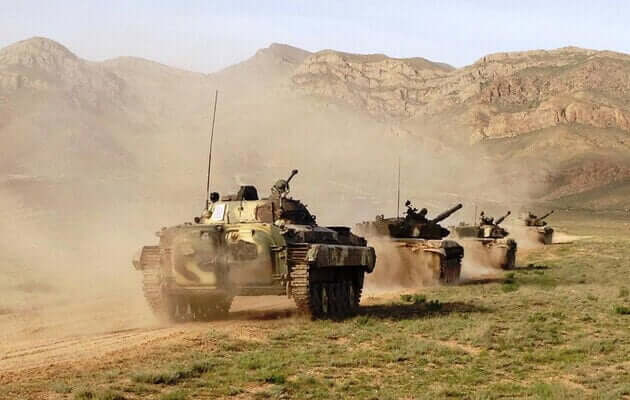
Russian President Vladimir Putin appears to have achieved a significant victory this week in Nagorno-Karabakh, which can change the geopolitical balance in the entire post-Soviet space in his favor, writes Anders Aslund for Atlantic Council…
The author notes that with this mediation between Azerbaijan and Armenia, Putin has succeeded in significantly expanding Russia’s military presence in the strategically important region of the South Caucasus. It is imperative that he did so without facing any opposition from the West. This uncontrolled advance should set off a wake-up call in other former Soviet republics such as Ukraine, Belarus, and Moldova.
The great lesson of the peaceful settlement between Azerbaijan and Armenia is the military power rules, the author notes. Within a few weeks, the use of force achieved what decades of diplomacy had failed to achieve. The only two relevant international players in the South Caucasus region are Russia and Turkey. The United States is on vacation, and the European Union is a paper tiger without troops.
The war between Armenia and Azerbaijan was one of four so-called “frozen” conflicts that erupted during the collapse of the Soviet Union. Joseph Stalin paved the way for hostilities decades ago when he handed over the ethnically Armenian territory of Nagorno-Karabakh (translated as “mountainous black garden”) to Azerbaijan. Aslund emphasizes that Stalin’s goal was to stimulate confrontation between Armenians and Azerbaijanis in order to keep these peoples under control…
Ethnic tensions erupted in 1988, which eventually led to a full-scale war between the two nascent independent states on the ruins of the Soviet empire. The war was stopped by an unstable ceasefire in 1994 when Armenian forces controlled not only Nagorno-Karabakh itself but also seven other nearby regions of Azerbaijan, forcing an estimated one million Azerbaijanis to flee.
The OSCE was supposed to resolve this conflict through diplomacy. It formed the so-called Minsk Group, which was co-chaired by Russia, the United States, and France. This format was maintained, but despite numerous meetings, no real breakthroughs were achieved in its work. Meanwhile, bloody battles continued to periodically flare-up on the front line of the barely frozen conflict, without leading to any serious shifts in the military balance.
On September 27, Azerbaijan launched an attack. Equipped with new Turkish and Israeli unmanned aerial vehicles, he overcame the Armenian defenses. Azerbaijani troops steadily moved forward and on November 9 occupied the ancient fortress city of Shusha in Nagorno-Karabakh… The Armenian forces seemed to be close to complete collapse.
After a series of previous diplomatic overtures, Putin has resolutely and seemingly with the consent of Turkey entered the battle. He concluded a joint declaration between Russia, Azerbaijan, and Armenia on the cessation of hostilities. It was signed by Putin, Armenian Prime Minister Nikol Pashinyan, and Azerbaijani President Ilham Aliyev.
In the first paragraph of the declaration, the three parties stated: “A complete ceasefire and all hostilities in the Nagorno-Karabakh conflict zone have been announced since midnight Moscow time, November 10, 2020. The Republic of Azerbaijan and the Armenian Republic … will stop at their current positions.”
Essentially, Azerbaijan again seized the territories that it lost in 1994 and captured one of the corners of Nagorno-Karabakh. In addition, the agreement promises Azerbaijan transport links through Armenia with the Azerbaijani region of Nakhichevan. Geographically, this settlement makes sense and can be durable.
Putin promised to deploy a peacekeeping contingent consisting of “1,960 soldiers with small arms, 90 armored personnel carriers and 380 vehicles and other special equipment” that will serve along the contact line in Nagorno-Karabakh and guard the Lachin corridor for an initial period of five years. Meanwhile, the Armenian armed forces will be withdrawn.
Russian special forces, many of whom fought in the Donbass, began arriving in Armenia on Il-76 transport planes on November 10. By sending these commandos as peacekeepers to Nagorno-Karabakh, Putin made tiny Armenia even more dependent on Russia, leaving it less like an independent nation and more and more like a Russian protectorate.
This result fits well with Russia’s foreign policy goals in the old Soviet quarter.
Armenian Prime Minister Nikol Pashinyan came to power through democratic protests in 2018 and is not a favorite of Putin, who is allergic to popular power movements and preferred to build relationships with the country’s previous kleptocratic rulers.
Angry Armenian Nationalists stormed government buildings in Yerevan amid news about the conclusion of an agreement with Russia and Azerbaijan, but Pashinyan clearly did not see a better alternative than to accept a humiliating peace agreement. Whatever happens next, Moscow is pleased to see that the champion of post-Soviet democracy is disgraced and discredited.
Turkish President Recep Tayyip Erdogan also emerged victorious from the conflict. The only international actors involved in this conflict and its settlements were Russia and Turkey. Turkey provided strong support to Azerbaijan, and Putin consulted with Erdogan, even though the ceasefire itself excluded Turkey. This leaves all arbitration disputes between Azerbaijan and Armenia in the hands of the Kremlin, even if it is not spelled out in the declaration.
Minsk Group, OSCE, USA, France, and the European Union – all this turned out to be irrelevant in the region, warns the author. The United States looks especially ridiculous since the foreign ministers of Armenia and Azerbaijan were in Washington on October 23. Both of them had separate meetings with Secretary of State Mike Pompeo, but they did not see each other and did not reach any agreement.
The nature of the conflict reflects the changing international environment… It seems that the United States has withdrawn, the EU lacks the military muscle, and the West as a whole has begun to distance itself from Turkey. This enabled authoritarian rulers like Putin and Erdogan to seize the geopolitical initiative. Indeed, the latest events in the South Caucasus go back to the words of the German Chancellor Otto von Bismarck of the 19th century: “The great issues of the day will be decided not by the speeches and decisions of the majority, but by iron and blood.”
From a geopolitical point of view, the most important outcome of the conflict is the emergence of a significant Russian military presence in Nagorno-Karabakh. Russian “peacekeeping” missions already exist in three other “frozen” post-Soviet conflicts. They are present in the Transnistrian region of Moldova, along with Abkhazia and South Ossetia in Georgia. A similar Russian military force is now firmly entrenched in the heart of the South Caucasus, fulfilling one of Moscow’s long-term missions in the region.
In particular, the passivity of the West during the Karabakh war is ominous for Ukraine. As a result, Russia was able to expand its military presence within the borders without encountering serious opposition from the West. As Ukrainian observer Vitaly Portnikov warns, this significantly increases the risk of Russian “peacekeepers” appearing in eastern Ukraine.
Only the signing of the Azerbaijani-Armenian-Russian ceasefire declaration stopped Armenia from complete defeat in the second Nagorno-Karabakh war. But if for Yerevan this agreement is an opportunity to stay on the edge of the abyss, then why would Baku sign a document when complete victory seemed so close? Read about the consequences of the war in the article Vladimir Kravchenko “The price of peace”.













